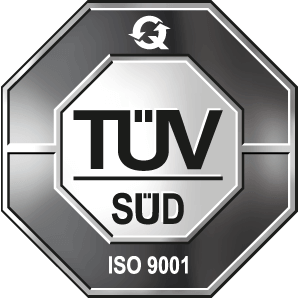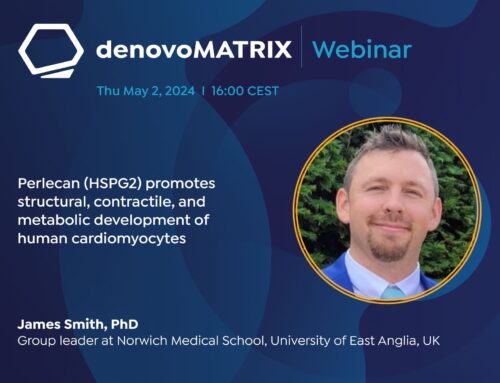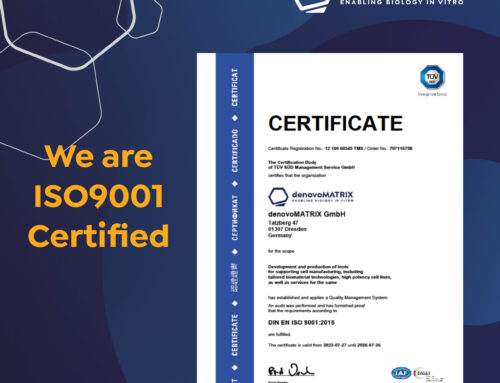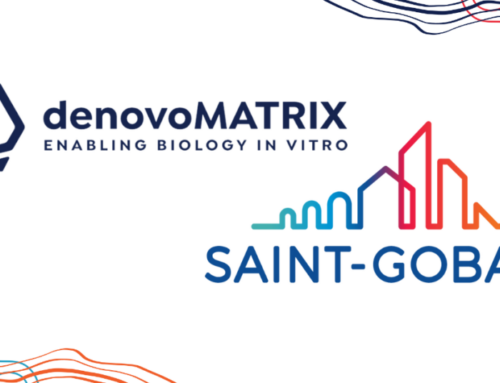by Alvin Kuriakose Thomas, Nadine Schmieder-Galfe, Yixin Zhang
Synthetic materials have become an integral part of healthcare devices such as implants, prosthetics, wearables etc. The development of synthetic biocompatible materials for tissue engineering using stem cells holds promising therapeutic opportunities.1,2 Pluripotent stem cells require a niche environment to maintain their ability to self-renew and differentiate.3 The in-vitro sustenance of several stem cell types has been well established on the extracted extracellular material, commonly known as Matrigel®, a gelatinous protein mixture secreted by cancerous mouse cells.4 In practice, extracted extracellular matrices are utilized to mimic the extracellular environment for generalized research purposes.5 However, the benefit of transplanting these stem cells cultured on the extracted material into patients, is limited due to the risks associated to its animal origins, immunogenic proteins and unknown pathogens. Another major concern of use such extracted biomaterials is the lack of medical grade quality, since the complex mixture of biomolecules is neither defined nor reproducible.6,7
In order to overcome these limitations, biologists are teaming up with chemists and engineers to study the extracellular environment using bottom-up approaches.8 The working principle is a defined bottom-up mimicry of the natural cell environment components that could be engineered as scaffolds on which cells of choice can be cultured and directed for therapeutics.9,10 The Zhang Lab [*] at the B CUBE Center for Molecular Bioengineering, Technische Universität Dresden has developed a biologically relevant, modular and customizable biomaterial. The biomimetic material is formed by non-covalently crosslinking glycosaminoglycan molecules to form bio-hybrid hydrogels.11 The material is versatile to presenting multiple functional synthetic peptides derived from natural extracellular proteins. The synthetic biomatrix is biocompatible and has been evaluated positively for its potential as cell-loaded 3D scaffolds, injectable biomaterial and drug release reservoirs.12–14
- Ahmed M. Screening of 3D biomaterials- A New Dimension in Biomaterials Research (or two?). J Tissue Sci Eng. 2012;3(4):3-4. doi:10.4172/2157-7552.1000e116.
- Jungebluth P, Alici E, Baiguera S, et al. Tracheobronchial transplantation with a stem-cell-seeded bioartificial nanocomposite: a proof-of-concept study. Lancet. 2011;378(9808):1997-2004. doi:10.1016/S0140-6736(11)61715-7.
- Wang X, Page-McCaw A. Wnt6 maintains anterior escort cells as an integral component of the germline stem cell niche. Development. 2018;145(3):dev158527. doi:10.1242/dev.158527.
- Hughes CS, Postovit LM, Lajoie GA. Matrigel: A complex protein mixture required for optimal growth of cell culture. Proteomics. 2010;10(9):1886-1890. doi:10.1002/pmic.200900758.
- Anderson JM. Comprehensive Biomaterials. Elsevier; 2015.
- Dingal PCDP, Wells RG, Discher DE. Simple insoluble cues specify stem cell differentiation: Fig. 1. Proc Natl Acad Sci. 2014;111(51):18104-18105. doi:10.1073/pnas.1421562112.
- Amber Dance. Ready, Set, Grow. The Scientist. https://www.the-scientist.com/?articles.view/articleNo/50155/title/Ready–Set–Grow/. Published 2017.
- Villa-Diaz LG, Ross AM, Lahann J, Krebsbach PH. Concise review: The evolution of human pluripotent stem cell culture: from feeder cells to synthetic coatings. Stem Cells. 2013;31(1):1-7. doi:10.1002/stem.1260.
- Mei Y, Saha K, Bogatyrev SR, et al. Combinatorial development of biomaterials for clonal growth of human pluripotent stem cells. Nat Mater. 2010;9(9):768-778. doi:10.1038/nmat2812.
- Nawy T. Move over, Matrigel. Nat Methods. 2017;14(1):10-10. doi:10.1038/nmeth.4138.
- Wieduwild R, Tsurkan M, Chwalek K, et al. Minimal peptide motif for non-covalent peptide-heparin hydrogels. J Am Chem Soc. 2013;135(8):2919-2922. doi:10.1021/ja312022u.
- Wieduwild R, Lin W, Boden A, Kretschmer K, Zhang Y. A Repertoire of Peptide Tags for Controlled Drug Release from Injectable Noncovalent Hydrogel. 2014.
- Wieduwild R, Krishnan S, Chwalek K, et al. Noncovalent Hydrogel Beads as Microcarriers for Cell Culture **. 2015:3962-3966. doi:10.1002/anie.201411400.
- Tondera C, Wieduwild R, Röder E, Werner C, Zhang Y, Pietzsch J. In Vivo Examination of an Injectable Hydrogel System Crosslinked by Peptide-Oligosaccharide Interaction in Immunocompetent Nude Mice. Adv Funct Mater. 2017;27(15):1605189. doi:10.1002/adfm.201605189.

picture credits: Richard Wetzel and Dejan Husman
[*] denovoMATRIX – EXIST-Forschungstransfer Project at the Zhang Lab,
B CUBE Center for Molecular Bioengineering, Technische Universität Dresden



